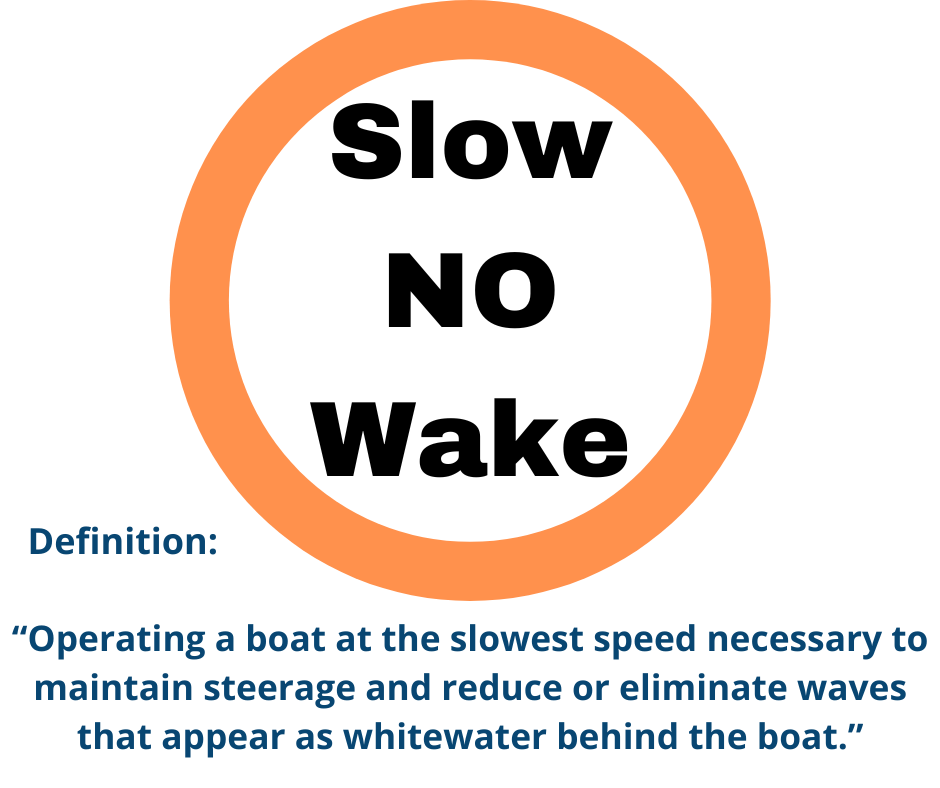 A "wake" refers to the path of moving waves a boat generates and is a product of the boat's size, weight, hull shape, boat speed, boat trim, and water depth. A boat propelled by the force of the engine transfers this energy into the wake.
A "wake" refers to the path of moving waves a boat generates and is a product of the boat's size, weight, hull shape, boat speed, boat trim, and water depth. A boat propelled by the force of the engine transfers this energy into the wake.
All boats create a wake, and all boaters are responsible for their wake. Changing how you operate your boat speed will also change the wake features. You can lower your impact on those around you. Paddlers also need to gain the skill of maneuvering into a wake
to prevent swamping or capsizing.
Watch your Speed:
As the boat operator, it can be easy to control your wake. Understanding the speeds under which your boat operates is the first step.
Displacement Speed: This is the slowest speed for most motorboats. It also creates the least wake. The boat operates with the bow down in the water.
Transition speed: As you increase power while attempting to get on-plane, the bow rises, causing the stern to plow through the water. This speed creates the largest wake.
Planing speed: This speed creates the least wake than in the transition speed, but more than displacement speed. Many larger boats are not designed to reach this speed.
Oregon has a specific definition for what it means to operate at "Slow -No Wake" speed: Violation of the snow -no wake rule is a Class B violation and can result in fines.
In Oregon, there are also “statewide proximity rules" for slow-no wake operation that apply on all waterways (OAR 250-010-0025): Operators of boats must operate at slow-no wake:
- within 200' of a boat ramp, marina, or moorage with a capacity for six or more boats
- a floating home moorage with six or more structures; or people working at water level.
The operator may be liable for damage caused by the wake. Often the boat operator can cause a large wake unintentionally. If you drop to the transition speed instead of down to the displacement speed, the wake size will increase. It's easy to avoid this pitfall by making a habit of checking your wake as it hits the shore.
The US Coast Guard has authority over the boat operations of commercial vessels.
Slow down far enough in advance of sensitive areas to give yourself time to drop to displacement speed. This will lessen your wake's impact. Wake boat operators should pick up surfers/wakeboarders by powering down and coming off-plane before entering a turn vs. a power turn. The time it takes to complete each type of turn is almost the same. But the power turn creates roller wakes that can stack with other waves. This situation can have negative impacts on others. A slow turn helps evenly disperse wakes.
Limiting Your Wake
- Be aware of your wake and the water depth. Shallow water yields larger wakes.
- Use the motor trim or trim tabs to help keep your boat level and limit your time in transition speed.
- Boat in deeper waters. Avoid getting close to other boats and the shore.
- Position passengers throughout the boat. A heavy stern will increase wake size.
- Wakeboard boats: avoid areas with a lot of docks or populated areas.
- Know the local area regulations which may be more restrictive than the statewide proximity rules in some areas.
What to do if you get “waked"
Chances are you will face a large wake created by someone else at some point. Here are some tips to safely navigate through a wake:
- Warn your passengers. Passengers below deck are especially at risk of hitting their heads or falling, so be sure they can hear you.
- Slow down before the wake arrives to lessen the impact, but don't cut the engine. You need headway to be able to maneuver through the wake.
- Have older passengers and others who are susceptible to injuries -stay aft.
- Instead of crossing a wake at a perpendicular angle, cross at a slight angle (a quarter of the wake). This will keep the bow from thrusting high in the air.
- While overtaking another boat, cross its wake quickly instead of riding it. Signal the operator; keep both hands on the wheel and stay away from the other boat's stern.
- Try not to take a wake on your beam. Instead, turn into the wake and come back on course when the wake has passed.
- If you are at anchor, allow for slack in the line so wakes don't cause the bow to lift and unseat the anchor.